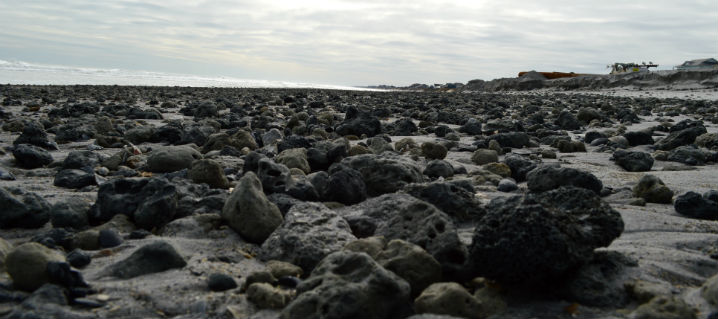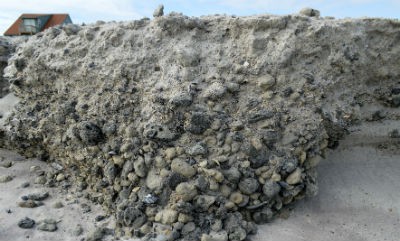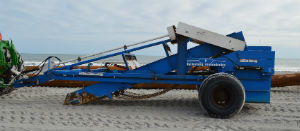
NORTH TOPSAIL BEACH – An ongoing effort to remove tons of rocks inadvertently pumped onto North Topsail Beach’s southern shoreline could extend well into the town’s future as regulatory agencies determine whether the rocks could affect nesting sea turtles.
Though dumping rocks on the beach bigger than three inches violates state standards for beach re-nourishment projects, officials at the N.C. Division of Coastal Management have decided not to stop the project or take other enforcement actions because the town is trying to remove the rocks.
Supporter Spotlight
Nearly a month has passed since the town began removing rocks mixed in with sand being pumped onto about a 3.5-mile stretch of beach extending to the town’s boundary line with Surf City as part of a beach re-nourishment project.
“The rocks are coming from our offshore borrow source,” said Stuart Turille, North Topsail Beach town manager.
There are more rocks in the sand than the pre-project sampling by contract engineer Coastal Planning & Engineering of North Carolina indicated, town and state officials said. The sand is being pumped from the seafloor about a mile to 1.5 miles from the beach.

When the project began in December, the sand seemed fine, Turille said. Early February storms, though, uncovered rocks of various sizes buried under the sandy surface.
Town officials began removing the rocks less than a week later, Turille said.
Supporter Spotlight
A mechanical picker has been plucking rocks off of the beach since Feb. 11. Two days later, boxes were installed at the ends of the discharge pipes to filter and collect rocks.
“The plan has been to work with CAMA to remove all rocks exceeding three inches in diameter,” Turille said. “We hired an off-road truck to remove the rock. The rocks are being placed on one of our leased lots. Rather than us remove it at our cost we’re letting area contractors use the rock and that saves us the transport cost. We’ve got it down to a system now.”
So far about 192 cubic yards of rocks have been removed, according to Adam Priest, project site manager with Chicago Bridge & Iron Co. To help visualize how many rocks have been hauled off, a large dump truck holds about nine cubic yards of material.
Officials with the N.C. Division of Coastal Management, which issues CAMA permits for beach re-nourishment projects, have been aware of the issue for some time, Doug Huggett, the division’s manager of Major Permits & Consistency, wrote in an email responding to questions. When the town applied for its permit, sampling done by the town’s contractor indicated that the sand would meet state standards for size and color, he explained.
“Therefore, we have been working with the town and their contractors, as well as the U.S. Army Corps of Engineers and the U.S. Fish and Wildlife Service, to implement corrective and remedial actions,” Huggett wrote. “Because the town and their contractors have been willing to work with us on resolving these issues we have chosen not to issue a notice of violation or shut the project down at this time. This course of action is consistent with the willingness of a permittee to resolve issues without having to resort to more formal sanctions that are available to use through our enforcement authority.”
The so-called “sediment criteria rule” went into effect in 2007 after beach re-nourishment projects on Oak Island and Pine Knoll Shores on Bogue Banks raised questions about the amount of shell and rock in the pumped sand. Sediment and shells larger than three inches in diameter are considered to be incompatible with the standard. The rocks at North Topsail, which consist of siltstone and limestone, range in size from small pebbles to basketball size.

They stunned Mike Giles, a coastal advocate for the N.C. Coastal Federation, when he visited the beach last week. “When I arrived I was shocked at the extent and size of the limestone rocks that literally covered the beach as far as you can see,” he said.
He saw rocks on the surface and extending through the entire depth of the pumped sand, which was almost over his head.
“What surprised me most is the fact this project had not been stopped as soon as this problem surfaced as required by state law,” Giles said. “The Division of Coastal Management has the responsibility to protect our coastal resources and ensure actions permitted by state and federal agencies follow the law. Unfortunately this problem will, pardon the pun, surface for years as the rocks down below are exposed. This same situation happened at Oak Island over 8 years ago and they are still picking up rocks off the beach”.
The 2001 sand-pumping project at Oak Island also spewed hundreds of tons of rocks onto the town’s beach. Despite years of rock-pickup efforts, Oak Island hasn’t been able to remedy the problem entirely. The town is still looking for methods and money to rid the beach of the rocks for good.
The North Topsail project is behind and clean up of the rocks could be an effort the town must continue past the project’s completion, according to an Army Corps of Engineers official.
“There could be potential for some effect on nesting turtles,” said Mickey Sugg, project manager in the corps’ Wilmington district office. “I would assume that there are rocks throughout the whole profile of the beach. At this time we’re focusing on the upper surface, but we have mentioned to them that there may likely be a long-term process of removal of the rock.”
Sugg said the Corps is currently talking with the U.S. Fish & Wildlife Service and the N.C. Wildlife Resources Commission about possible long-term rock removal at North Topsail Beach.
Engineers have tried unsuccessfully to find areas where there is less rock throughout the town’s one offshore site.

“They only have the one borrow site,” Sugg said. “It’s not exposed hard bottom. If they were working in exposed hard bottom they would be shut down by now.”
Winter storms have delayed the project, which is permitted through April 30 – the cutoff before the start of sea turtle nesting season.
“The real concern is that the last 30 or so days we’ve got a high rate of downtime on the project and we really need to get back on track,” Turille said.
The town may request an extension on the project past the April 30 permit. Sand nourishment projects are prohibited between May 1 and Nov. 15 without approval from the N.C. Division of Coastal Management, the state Wildlife Resources Commission, the Fish & Wildlife Service and the Corps.
“It’s a bit premature for me to tell you what I haven’t asked CAMA yet,” Turille said. “That’s certainly something we’re considering at this time. We need that beach. We take coastal protection very seriously. The very existence of this town is predicated on preserving the environment. We do not cut any corners on any environmental protection.”







